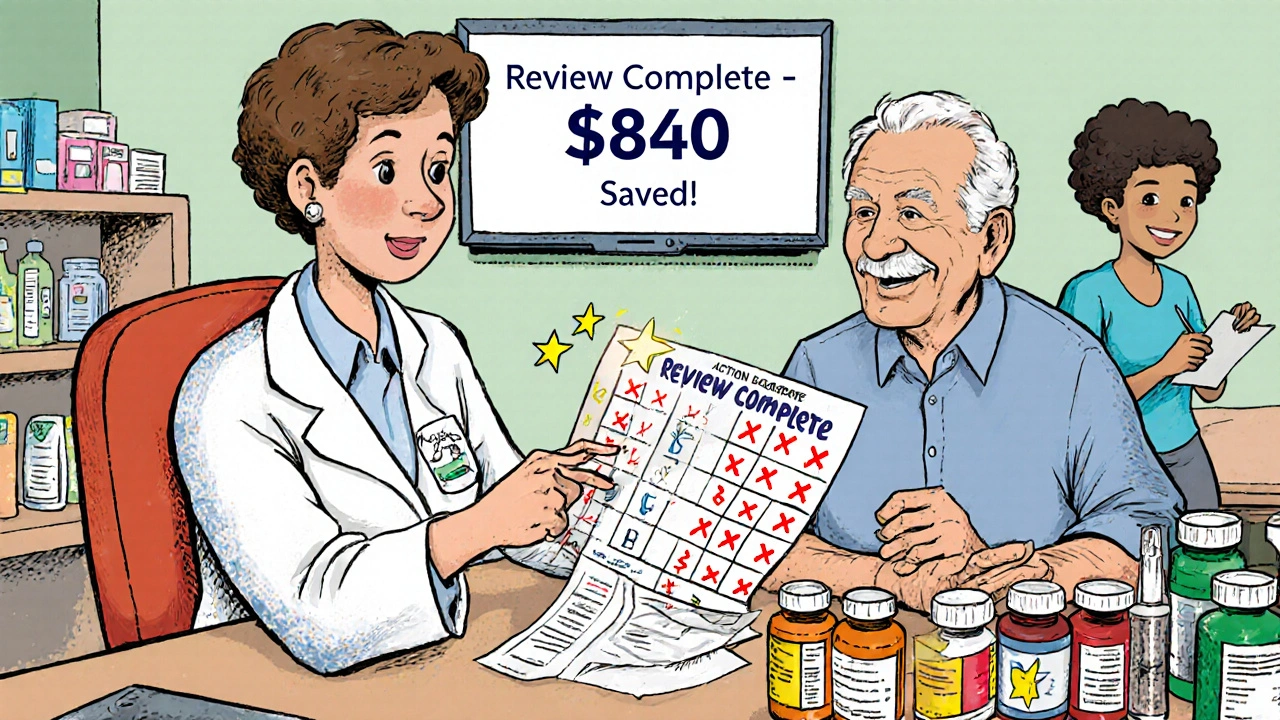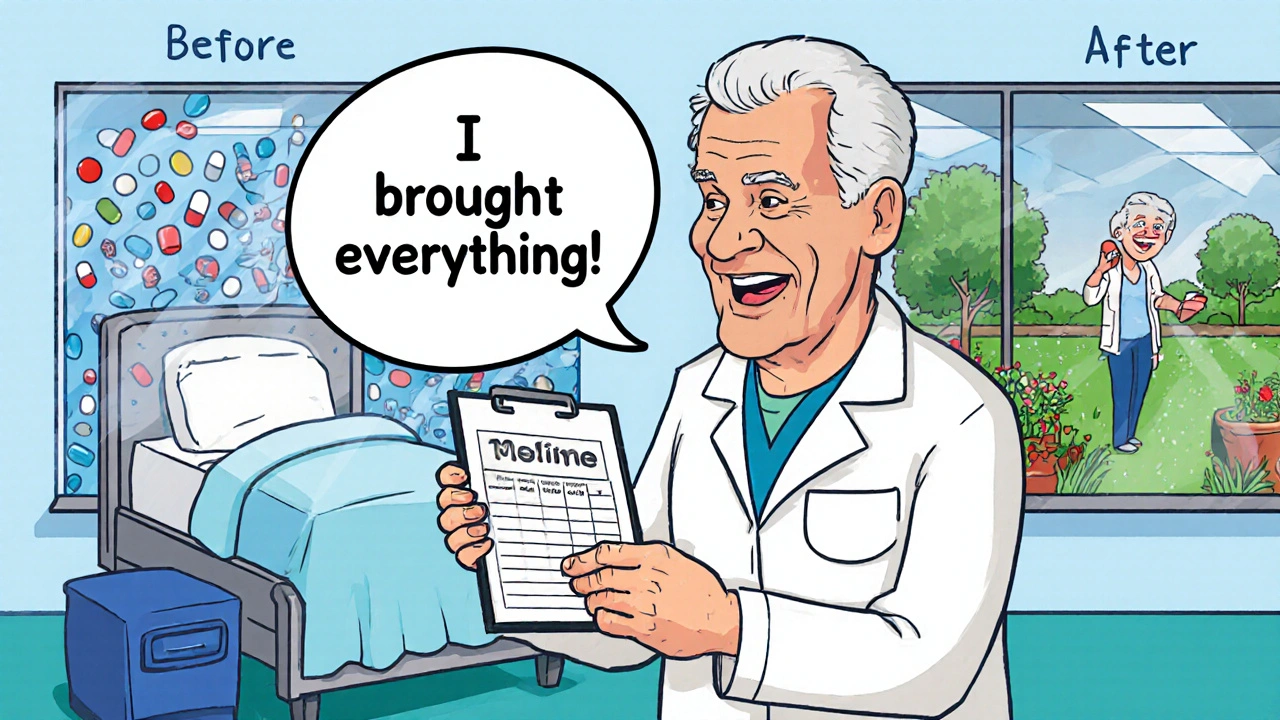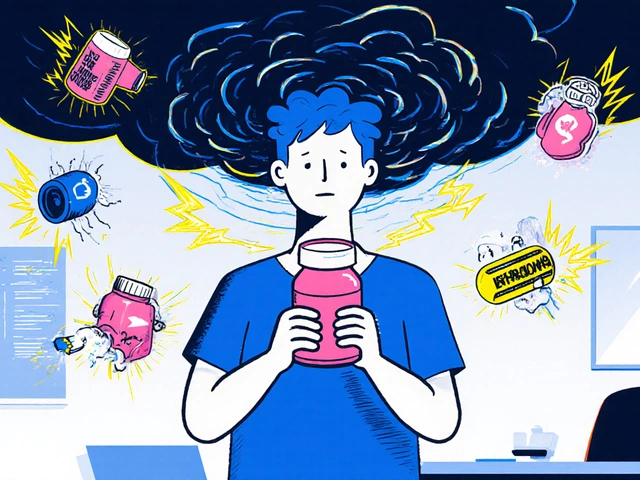Every year, millions of seniors on Medicare get a free, one-on-one session with a pharmacist to review all their medications. It’s called the Medicare Annual Medication Review, or Comprehensive Medication Review (CMR). But here’s the catch: if you don’t show up prepared, you’re wasting a chance to catch dangerous drug interactions, save money, or fix confusion about your pills. This isn’t just a chat-it’s a safety net built into your Medicare Part D plan. And if you’re taking eight or more medications, have three or more chronic conditions, or spend over $1,623 a year out-of-pocket on prescriptions, you’re eligible. But being eligible doesn’t mean you’ll get the full benefit. You have to show up ready.
What Exactly Happens During a Medicare Annual Medication Review?
The review isn’t a quick check-in. It’s a full 30- to 60-minute conversation with a licensed pharmacist, done in person or over video call. They don’t just look at your prescriptions. They ask about every pill, capsule, gummy, herb, or supplement you take-even the ones you bought without a prescription. That includes your ibuprofen, your fish oil, your melatonin, your garlic tablets, and that turmeric powder you started last winter.
The pharmacist compares everything you say you take with what’s on file from your pharmacy claims. Then they look for:
- Duplicate medications (like taking two different painkillers that do the same thing)
- Drug interactions (like blood thinners mixing dangerously with certain herbal supplements)
- Medications you no longer need but keep taking
- Side effects you haven’t told your doctor about
- Costly alternatives that work just as well
- Confusing instructions (like “take with food” when you’ve been taking it on an empty stomach)
At the end, you get three documents: a summary letter, a personalized action plan, and a printed list of all your medications. These aren’t just paperwork-they’re tools you can take to your doctor, share with family, or keep in your wallet.
Why Most People Miss the Point
According to Medicare Rights Center data, 78% of seniors who came prepared said the review helped them. But only 42% of those who showed up with no list or no bottles felt it was useful. Why? Because the pharmacist can’t fix what they can’t see.
One user on Reddit shared how she found out her fish oil was making her blood thinner too strong-something her doctor never caught. Another man rescheduled his review because he didn’t bring his pill bottles and the pharmacist couldn’t verify doses. He missed three weeks of managing his diabetes meds correctly because he didn’t prepare.
The truth is, most people think the pharmacist already knows what they take. They don’t. Claims data is often outdated, incomplete, or wrong. Studies show seniors forget to mention 2 to 3 medications on average during these reviews. That’s not a small mistake-it’s a health risk.
Step-by-Step: How to Prepare in 90 Minutes or Less
You don’t need to be a medical expert. You just need to be organized. Here’s how to get ready, broken into simple steps.
Step 1: Gather Every Single Medication You Take
Go through every drawer, cabinet, purse, and bedside table. Collect everything-even the ones you haven’t taken in months. Don’t skip:
- Prescription drugs (even if you stopped taking them)
- Over-the-counter pain relievers (Tylenol, Advil, Aleve)
- Vitamins and minerals (vitamin D, calcium, B12)
- Herbal supplements (ginkgo, echinacea, St. John’s wort)
- Dietary supplements (fish oil, collagen, probiotics)
- Topical creams or patches (like lidocaine patches or nicotine patches)
Bring them in their original containers. Labels have the exact name, dose, and instructions. If you don’t have the bottle, write down the name, strength, how often you take it, and why you take it. Don’t guess. If you’re not sure, leave it out and ask the pharmacist.
Step 2: Write Down Your Top 3 Concerns
What’s bothering you about your meds? Be specific. Don’t say “I feel weird.” Say:
- “I get dizzy every time I take my blood pressure pill after lunch.”
- “I’ve been forgetting to take my cholesterol medicine twice a week.”
- “My stomach hurts every time I take the arthritis pill.”
- “This pill costs $120 a month-is there a cheaper one?”
Write these down. Bring the list. You’ll forget them in the moment. The pharmacist can’t help with problems they don’t know exist.
Step 3: Note Recent Health Changes
Have you been hospitalized? Had a fall? Lost weight? Started a new diet? Had new lab results? These matter.
For example: if your kidney function dropped last month, your doctor might need to adjust your blood pressure meds. If you’ve been sleeping more than usual, it could be a side effect of a new drug. Write down any changes in the last 3 months-even if you think it’s unrelated.
Step 4: Create a Simple Medication Timeline
Take 15 minutes to make a quick chart:
| Medication | Dose | When Started | Why | Any Changes? |
|---|---|---|---|---|
| Lisinopril | 10 mg | Jan 2023 | High blood pressure | Increased from 5 mg in June 2024 |
| Metformin | 500 mg | Mar 2022 | Diabetes | None |
| Calcium + D | 1200 mg / 800 IU | Oct 2023 | Bone health | Added after hip X-ray |
| Advil | 200 mg | As needed | Joint pain | Started taking daily last month |
This helps the pharmacist spot patterns. Maybe you started taking Advil daily and now your stomach is upset. Maybe your blood pressure dropped after you added a new supplement. This timeline turns vague complaints into clear clues.
Step 5: Bring Someone With You
It’s easy to forget what’s said in a 45-minute conversation. Bring a family member, friend, or caregiver. They can help remember questions, take notes, or ask things you didn’t think of. Many seniors say their spouse caught the most important point: “They didn’t realize I was taking two kinds of aspirin.”

What to Expect After the Review
Right after your session, you’ll get a printed Personal Medication List. This is your official, updated list of everything you should be taking. Keep it in your wallet, on your fridge, or give a copy to your doctor.
You’ll also get a Medication Action Plan. This tells you what to do next:
- Stop taking a medication
- Switch to a cheaper brand
- Call your doctor about a side effect
- Get a new lab test
And you’ll get a Consultation Letter that explains the changes in plain language. This isn’t just for you-it’s for your doctor too. Many doctors don’t know what’s happening in your pharmacy visits. This letter fills the gap.
What If You Don’t Qualify?
You might not meet the official eligibility rules-maybe you only take four medications, or your out-of-pocket costs are under $1,623. That doesn’t mean you shouldn’t get a review.
Many pharmacies offer free medication reviews even if you’re not eligible for the Medicare CMR. Ask your pharmacist: “Can you do a full review of all my meds, even if Medicare doesn’t pay for it?” Most will say yes. It takes 20 minutes. It’s free. And it could save your life.
Also, CMS updated its rules in 2024 to include people with just two chronic conditions if they’re at high risk. If you have heart disease and COPD, or diabetes and kidney disease, you might qualify even if you don’t take eight pills. Call your plan directly and ask: “Do I meet the new expanded criteria?”
Common Mistakes to Avoid
- Don’t rely on memory. Write it down. Bring bottles.
- Don’t skip OTCs and supplements. These cause the most dangerous interactions.
- Don’t be embarrassed. Pharmacists have seen it all. They won’t judge you for forgetting a pill or taking too much ibuprofen.
- Don’t wait for them to call. If you’re eligible, they’re supposed to reach out. But if you haven’t heard from them in 10 months, call your Part D plan. Ask: “When is my annual medication review scheduled?”

Real Results: What People Actually Gain
People who prepare properly walk away with real wins:
- One woman saved $840 a year by switching from a brand-name blood thinner to a generic she didn’t know existed.
- A man stopped taking a sleep aid that was making his memory worse-his pharmacist found it was interacting with his antidepressant.
- A couple discovered their father was taking two different versions of the same cholesterol drug. Stopping one cut his risk of muscle damage.
- A veteran found out his VA-prescribed painkiller was conflicting with his Medicare-prescribed anxiety med. He got a safer alternative within a week.
These aren’t rare cases. They’re routine outcomes of a properly done review.
What’s Changing in 2025
The rules are getting better. The cost threshold dropped from over $2,000 to $1,623, meaning more people qualify. Part D plans are now using electronic health records to pull in your data faster. Some are even testing AI tools that send you a pre-review checklist via text or email.
And in 2026, CMS plans to make these reviews mandatory for all eligible beneficiaries-not just offered. That means if you qualify, you’ll get one, no matter what.
The goal is simple: fewer hospital stays, fewer ER visits, fewer bad reactions. And it starts with you showing up with your pill bottles in hand.
Who qualifies for a Medicare Annual Medication Review?
You qualify if you have at least three chronic health conditions (like diabetes, heart disease, or COPD), take eight or more Medicare Part D-covered medications, and spend over $1,623 out-of-pocket on those drugs in a year. New rules in 2024 also allow people with two high-risk chronic conditions to qualify, even if they take fewer pills.
Do I need to pay for this review?
No. The Medicare Annual Medication Review is completely free. It’s a required benefit under your Medicare Part D plan. There are no copays, no fees, and no hidden charges.
Can I do the review over the phone or video call?
Yes. You can choose to do the review in person at a pharmacy, over the phone, or via video call. Many people prefer video because it’s easier to show pill bottles and ask questions without leaving home.
What if I forget to bring my medications?
If you don’t bring your pills or a complete list, the pharmacist won’t be able to verify what you’re actually taking. They may have to reschedule you. This delays help and puts you at risk. Always bring bottles or a written list with names, doses, and how often you take them.
Will my doctor be told what happens in the review?
Yes. After your review, the pharmacist sends a summary letter to your doctor and any other prescribers. This ensures everyone on your care team knows about changes, concerns, or new recommendations.
How often do I get a medication review?
Once every 12 months. Your Part D plan is required to offer you a new review each year. If you haven’t been contacted in over a year, call your plan directly to schedule it.
What if I don’t like the changes suggested?
You’re in control. The pharmacist makes recommendations, but you decide what to do. You can say no to stopping a medication, switching brands, or calling your doctor. But if you say no, ask why-sometimes the reason is a simple fix you didn’t know about.
Next Steps: Don’t Wait
If you’re on Medicare Part D and take more than a few medications, your next step is simple: call your plan. Ask: “When is my next Annual Medication Review?” If you haven’t had one in the last 11 months, schedule it now. Don’t wait for them to call.
Then, set aside 90 minutes this week to gather your pills, write down your concerns, and make a simple list. You won’t need a medical degree. You just need to be ready. Because the next time you’re on the phone with a pharmacist, you don’t want to be guessing what you take. You want to be in control.




Amie Wilde
Just did my review last week. Brought my whole medicine cabinet. Turned out I was double-dosing on ibuprofen and my pharmacist caught it. Saved me $700 a year too. Don’t sleep on this.
Gary Hattis
I’m from India and my sister’s in the US on Medicare. I showed her this guide and she cried because she’d been taking five supplements she didn’t need-her doctor never asked. This isn’t just American stuff. It’s universal. Pharmacies everywhere should do this. Why don’t they?
Esperanza Decor
I’m 72 and took my meds to the review without even thinking I needed to. Turned out my fish oil was messing with my blood thinner. The pharmacist said most people forget supplements entirely. I wrote down my three biggest worries: dizziness, memory fog, and the $150 monthly bill for one pill. She fixed all three. I told my book club about it. Everyone’s scheduling theirs now. You don’t need to be a genius-you just need to show up with your bottles.
Deepa Lakshminarasimhan
They say this is free but I think it’s a trap. What if they use your meds list to sell you more stuff? Or worse-report you to some government database? My cousin’s neighbor got flagged because she took melatonin and now they’re sending her ‘wellness surveys’ every week. I’m not bringing anything. I’ll just say I take aspirin and call it a day. Better safe than sorry.
Erica Cruz
Wow. Another ‘guide’ telling seniors they’re too dumb to manage their own meds. Let me guess-the real goal is to get pharmacists more access to your medical data so Big Pharma can upsell you? This isn’t ‘help,’ it’s surveillance wrapped in a freebie. And why is everyone acting like this is revolutionary? My grandma’s been doing this since 1998. She just called her doctor and read her list out loud. No checklist needed. This article is just corporate fluff.
Johnson Abraham
bruh i just told my pharmacist i take ‘the blue one for heart, the white one for sugar, and the green one for sleep’ and he was like ‘cool’ and didn’t even blink. why are we making this so complicated? just say what it does. nobody cares about the brand names. also i brought my pills in a ziplock bag. so what? it’s not a crime.
Shante Ajadeen
I helped my mom prep for hers last month. We sat at the kitchen table with her meds spread out like a puzzle. She was nervous, but the pharmacist was so kind. She ended up stopping two pills that were making her dizzy and switched to a cheaper generic. Now she’s sleeping better and saving $60 a month. If you’re even a little unsure about your meds-do this. It’s not scary. It’s like a health checkup for your pills.
dace yates
What if you don’t have a phone or internet to schedule it? My neighbor can’t afford data and her plan never called. She didn’t even know this was a thing until her daughter found this post. Is there a way to get help if you’re low-income or isolated?